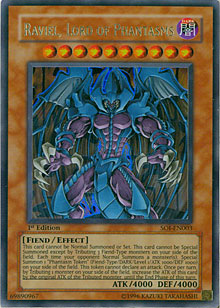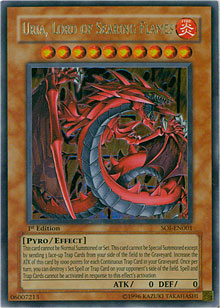We’ll continue our discussion from last week by looking at the last two Sacred Beasts, Raviel, Lord of Phantasms and Uria, Lord of Searing Flames. While Hamon, Lord of Striking Thunder had two separate effects that involved two separate strategies, Raviel and Uria are more focused on a single strategy that utilizes both effects.
Raviel, Lord of Phantasms
 With 4000 ATK and 4000 DEF, Raviel is already a force to be reckoned with, but its effects add a bit more for your opponent to fear. “This card cannot be Normal Summoned or Set. This card cannot be Special Summoned except by Tributing 3 Fiend-Type monsters on your side of the field. Each time your opponent Normal Summons a monster(s), Special Summon 1 "Phantasm Token" (Fiend-Type/DARK/Level 1/ATK 1000/DEF 1000) on your side of the field. This token cannot declare an attack. Once per turn, by Tributing 1 monster on your side of the field, increase the ATK of this card by the original ATK of the Tributed monster, until the End Phase of this turn.”
With 4000 ATK and 4000 DEF, Raviel is already a force to be reckoned with, but its effects add a bit more for your opponent to fear. “This card cannot be Normal Summoned or Set. This card cannot be Special Summoned except by Tributing 3 Fiend-Type monsters on your side of the field. Each time your opponent Normal Summons a monster(s), Special Summon 1 "Phantasm Token" (Fiend-Type/DARK/Level 1/ATK 1000/DEF 1000) on your side of the field. This token cannot declare an attack. Once per turn, by Tributing 1 monster on your side of the field, increase the ATK of this card by the original ATK of the Tributed monster, until the End Phase of this turn.”
When you special summon Raviel, it’s useful to know that you can also tribute face-down Fiend-type monsters. You can also use a card like DNA Surgery to alter the type of all face-up monsters to Fiend, allowing you to use monsters that aren’t normally of the Fiend type to help fulfill Raviel’s summoning requirement. For example, monster tokens generated by Scapegoat and Blockman will work quite well for this purpose once they’ve been changed into Fiend-type monsters.
Now that Raviel has entered the battle, let’s see how its effects function in the duel.
Raviel’s first effect activates whenever your opponent normal summons a monster. Since it is a trigger effect, it’s possible for both players to respond with their own card effects. For example, if you have only three remaining monster card zones when Raviel’s effect activates, your opponent could chain with Ojama Trio to fill them and prevent your Phantasm token from being special summoned.
Let’s look at a more likely scenario. Raviel’s effect isn’t the only effect you have that wants to respond to your opponent’s normal summon of a monster. What if you have Bottomless Trap Hole set with Raviel face-up on your side of the field and your opponent normal summons D. D. Assailant? That card is likely to ram itself into Raviel or go after your Phantasm token, so eliminating it with Bottomless Trap Hole sounds mighty good.
Raviel’s trigger effect will activate immediately when your opponent normal summons his or her monster, so you know that it will already begin the chain. The only remaining question is whether you can also activate your Bottomless Trap Hole. The answer is an affirmative yes. The activation requirement for Bottomless Trap Hole is still satisfied, even though Raviel has begun a chain. The activation of Raviel’s effect does nothing to eliminate the timing window, so it’s perfectly fine for Bottomless Trap Hole to be activated and added to the chain along with Raviel’s effect.
When Raviel’s effect activates, the opponent will have a chance to respond. If he or she responds with a counter-trap, it would no longer be possible for the player with Raviel to use Bottomless Trap Hole. The odds of this occurring are quite low, so you probably won’t have to worry about it much.
When the effect is resolved, you special summon one Phantasm token onto your side of the field in the battle position of your choice. This token has a condition placed upon it that prevents it from attacking, but any other purpose you have for it will work just fine. Tributing it for a summon or a card effect, or just keeping it around as an added line of defense are all perfectly valid uses for that Phantasm token.
This brings us to Raviel’s second effect, which lets you tribute any monster on your side of the field (except for Raviel itself) to increase Raviel’s ATK by the original ATK value of the tributed monster. This is an ignition effect that you can only activate once per turn (during one of your main phases), so don’t count on it helping you out during your opponent’s turn. However, it will help you to generate even greater ATK strength for your Raviel before you go on the offensive, easily pushing it beyond the ATK and DEF values that most monsters are capable of.
Uria, Lord of Searing Flames
 We conclude our look into the Sacred Beasts with Uria, Lord of Searing Flames. “This card cannot be Normal Summoned or Set. This card cannot be Special Summoned except by sending 3 face-up Trap Cards from your side of the field to the Graveyard. Increase the ATK of this card by 1000 points for each Continuous Trap Card in your Graveyard. Once per turn, you can destroy 1 Set Spell or Trap Card on your opponent's side of the field. Spell and Trap Cards cannot be activated in response to this effect's activation.”
We conclude our look into the Sacred Beasts with Uria, Lord of Searing Flames. “This card cannot be Normal Summoned or Set. This card cannot be Special Summoned except by sending 3 face-up Trap Cards from your side of the field to the Graveyard. Increase the ATK of this card by 1000 points for each Continuous Trap Card in your Graveyard. Once per turn, you can destroy 1 Set Spell or Trap Card on your opponent's side of the field. Spell and Trap Cards cannot be activated in response to this effect's activation.”
When players read Uria’s effect, they may come to the erroneous conclusion that only continuous trap cards can be used to special summon it. This is not the case. You are free to use any face-up trap cards you control. While this usually means using continuous traps, some traps remain face up on the field even though they aren’t continuous traps, and they’ll work just as well for summoning Uria.
Metalmorph and Blast with Chain both fill this role quite well. Each trap equips to a monster on the field, allowing them to remain when other traps would be removed. This allows you to strengthen your monsters on the field while also preparing for the arrival of Uria. Keep in mind, however, that while they may help you summon Uria, they won’t help you to increase its ATK value.
Uria’s ATK is increased by 1000 points for each continuous trap in your graveyard. Assuming you used three continuous traps to special summon Uria, and with no other continuous traps in your graveyard, this would put it at 3000 ATK. When a player creates a deck that’s based around Uria, the selection of continuous traps is likely to support this ATK increase, as well as the deck’s overall theme. However, some choices will actually hinder Uria.Rivalry of Warlords is one such card. While it is active, it can actually prevent you from special summoning Uria if you control a face-up monster that isn’t a Pyro-type monster. In order to avoid this, you’ll either need to have no face-up monsters at all, or you’ll need all of your face-up monsters to be Pyro-type monsters.
Now, the stage will be set for Uria’s final act—the destruction of one of your opponent’s set spells or traps. This effect is unique among all other monster effects, because it’s nearly unstoppable. When a player declares the activation of Uria’s effect and selects the target, neither player is able to activate a spell or trap in response. Even Divine Wrath, a card that would normally negate a monster’s effect, cannot be used in response to Uria’s effect. Multi-trigger effects of monster cards could be activated in response, but the actual potential for impact is rather limited. Uria’s effect will typically resolve without any interference and destroy its intended target, just as planned. What it does from there is up to you.
Until next time, send all comments to Curtis@metagame.com.